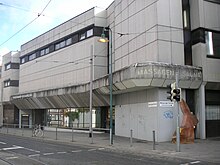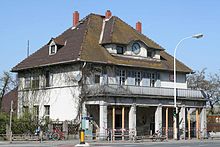Darmstadt Bessungen
|
Qualifications
Independent city of Darmstadt
|
|
|---|---|
| Coordinates: 49 ° 51 ′ 28 " N , 8 ° 39 ′ 4" E | |
| Height : | 179 m above sea level NN |
| Area : | 5.53 km² |
| Residents : | 14,283 (Dec. 31, 2015) |
| Population density : | 2,583 inhabitants / km² |
| Incorporation : | April 1, 1888 |
| Postal code : | 64285, 64295 |
| Area code : | 06151 |
|
Location of Bessungens in Darmstadt
|
|
Bessungen is a district of the independent city of Darmstadt in southern Hesse . Until 1888 Bessungen was an independent municipality. The reputation as the "oldest part of Darmstadt" goes back to Bessungen's first mention in 1002. However, this only applies to the “core area of Darmstadt”, as the suburb of Eberstadt , which was incorporated in the 20th century, was mentioned earlier. Bessungen was actually founded by the Alamanni in the 5th century .
geography
Bessungen is located in the south of the Darmstadt core city.
Geographical location
The first foothills of the Vorderen Odenwald in the southeast, such as Herrgottsberg, Moosberg and Ludwigshöhe, create a rather hilly terrain. The Saubachgraben forms the southern border of the district. East of Nieder-Ramstädter Straße are the Darmstadt Ostwald and the Lichtwiese. To the west to the Heimstättensiedlung and to the north to the city center, the area becomes flatter, as these districts are already in the Upper Rhine Plain .
structure
Today's Bessunger townscape can be described as rather heterogeneous, but this also defines the character of the district. The last surviving village-rural courtyard structures partly meet the high and dense block development of the 19th and 20th centuries: The Bessunger Church forms the core of the village development that stretches along Ludwigshöhstrasse and Niederstrasse. The stately residential buildings of the Wilhelminian era can be found in Heidelberger Strasse and Moosbergstrasse . Bessungen also includes the Paulusviertel to the east, a residential area planned by Darmstadt's TH professor Friedrich Pützer from 1900 with strong borrowings from the garden city movement . To the east of the Paulusviertel, beyond Nieder-Ramstädter Straße and bordering the city area, are the Alte Darmstädter Friedhof, the Lichtwiese campus of the Technical University of Darmstadt and extensive sports facilities at the Böllenfalltor . In the west of the Donnersbergring, the change from block to line structure in the 1950s shows the end of the Bessunger core area. In the north, Bessungen borders Darmstadt city center. The Heidelberger Landstrasse leads south to Eberstadt .
history


Archaeological finds indicate that Bessungen was founded in the 4th or 5th century at the latest. The part of the name "-ingen" or, in a slurred form, "-ungen" also indicates an Alemannic origin of the settlement. The name is to be interpreted as "with the people of Bezzo", whereby that Bezzo (modified form of Bernhard) is probably an Alemannic nobleman, whose followers settled in that village. Medieval Bessungen developed at the intersection of old Roman roads .
Bessungen was first mentioned in a document on June 10, 1002: In a document from Emperor Heinrich II , Bessungen (old: Bezcingon ), then part of the Gerau court , was awarded to the diocese of Worms , in 1009 again to the diocese of Bamberg and finally on 21. June 1013 to the diocese of Würzburg .
In 1259, the Bishop of Würzburg awarded the Gerau royal court to the Lower County of Katzenelnbogen . In contrast to Darmstadt, the importance of Bessungen declined in the following years, so that in 1369 Archbishop Gerlach of Mainz removed the Marienkapelle in Darmstadt from the mother church in Bessungen, elevated it to the parish church, and thus moved the ecclesiastical center to Darmstadt.
In 1479, Bessungen was inherited by the Landgraviate of Hesse .
Bessungen only barely survived the Thirty Years' War , in 1646 it had only 30 inhabitants. It was only with the increasing importance of the neighboring Darmstadt residence that Bessungen experienced a certain boom at the beginning of the 18th century: the Parforcehof , the orangery and the Mosersche Garten (later Prince Emil's garden and palace - today Prince Emil Garden ) were built in Bessungen . The village grew with the arrival of court officials and servants. At the beginning of the 19th century, Darmstadt became the center of the Grand Duchy of Hesse-Darmstadt , which led to a strong expansion of the urban area. Darmstadt and Bessungen finally grew together by 1875 at the latest.
On April 1, 1888, after lengthy negotiations, Bessungen was incorporated into Darmstadt. The intensive construction activities subsided after the turn of the century. Bessungen was largely spared from the bombings of the Second World War (see Darmstadt , Brandnacht ).
Religions
The Catholic Church of Our Lady as well as the Protestant churches of Bessunger Church (Petrusgemeinde), Andreasgemeinde, Pauluskirche and the Christian community Michaeli are in Bessungen (for the historical role of the Bessunger Church, see above under History ). The headquarters of the Evangelical Church in Hesse and Nassau is located on Paulusplatz . Darmstadt's Jewish cemetery is located on Seekatzstrasse .
Population development
Today Bessungen is a popular residential area with a mixed social structure. The population development is correspondingly relatively stable with a slightly negative trend recently (as of April 2005).
In a public survey carried out in 2009, Bessungen was voted Darmstadt's most popular district.
See also
politics
Bessungen does not have its own local advisory board . All matters relating to assessments are dealt with in the city parliament and magistrate of Darmstadt. However, all major parties have local chapters.
In terms of voter behavior, Bessungen is considered a red-green stronghold. Thus, Alliance 90 / The Greens regular third-strongest force with shares of votes in the double-digit percentage range. However, in the local elections in 2006, the CDU succeeded in becoming the strongest force in almost all of the Bessunger electoral districts.
Coat of arms and Ortsneckname
The Bessung coat of arms shows the tripod , a court chair. Leimdippche (glue pots) and lapping ( wild rabbits ) are Bessungen's landmarks. According to legend, Landgrave Georg I failed his first attempt to settle wild rabbits around 1570, as they were all fetched by the fox. A second attempt turned into the opposite; the rabbits multiplied just like the rabbits in the now fenced off protected area and soon became a nuisance.
A real Bessunger is therefore often called "lapping". A Lapping also decorates in the Bessunger notch (see Kirchweih ) the Kerwe tree ( Kirchweih tree ). Until 2006 there was a dead rabbit on the wreath, but since 2007 it has been replaced by a rocking rabbit with a carrot. Lapping is derived from the French lapin (rabbit) and probably dates from the time when Darmstadt was occupied by the French in the 18th century.
Culture and sights
theatre
- Comedy Hall / former Bessunger gym (Kikeriki puppet theater for children and adults)
- Comedy TAP (theater; disbanded in 2014)
music
- Academy for Tonkunst
- Jagdhofkeller (jazz concerts) and Darmstadt Jazz Institute in the Kavaliershaus
- Bessunger boys school cultural center
Buildings
Parks

Three larger parks, the Orangery Garden , Prinz-Emil-Garten and Wolfskehl'scher Park, as well as the proximity to Lichtwiese and Darmstadt Ostwald, have an impact on the townscape . There is also the small park in Ingelheimer Garten .
Natural monuments
In the Bessungen are nature reserve Bessunger trout pond , the nature reserve Bessunger gravel pit , as well as the natural monuments force rest , Mr. Gottberg and Goethe rocks and oak and acacia wood at the Spruce Street.
Sports
The facilities at Böllenfalltor include the outdoor swimming pool in the university stadium and the SV Darmstadt 98 stadium . The renovated Bessunger indoor swimming pool is located near the former Bessunger boys' school ("Bessunger Buweschul"), now a cultural center. The VCD cycling track and the tennis courts of the Bessungen tennis club are located on Heidelberger Strasse. The grounds of the TG Bessungen are on the other side of Karlsruher Strasse . The annual Bessunger District Run enjoys great participation from athletes and spectators.
Regular events
- Spring awakening (end of April, pub night with live bands)
- "Gartenlust" (end of April, in the orangery garden)
- "Brunnebittfest" and flea market (June, Forstmeisterplatz)
- Bessunger Curb (3rd weekend in September, orangery garden)
- Christmas market (1st and 2nd Advent, Forstmeisterplatz)
Economy and Infrastructure
traffic
Major roads for motor vehicle traffic are Heinrichstrasse, Heidelberger Strasse (formerly B 3 ), Landskronstrasse, Klappacher Strasse and Nieder-Ramstädter Strasse ( B 449 ).
Seven lines of the Darmstadt tram, running essentially in a north-south direction, connect Bessungen with the rest of the city: In the west, lines 1, 6, 7, 8; in the middle line 3 and in the east lines 2 and 9. At the Böllenfalltor there is also the depot for the HEAG buses and trams as well as a smaller regional bus station.
media
- Bessunger new messages
Public facilities
- Institute for Housing and Environment (IWU) (moved away in 2013)
- Marienhospital Darmstadt (at the Böllenfalltor)
- Neighborhood home forester's office
- Neighborhood home Prinz-Emil-Schlösschen
- Police Headquarters South Hesse (at the Böllenfalltor)
- Bessungen district library (dissolved in 2013)
education
- Bessunger School ( Primary School )
- Edith Stein School (state-recognized Catholic high school)
- Technical school for social pedagogy
- Georg Büchner School , formerly "Altes Realgymnasium" (grammar school)
- Heinrich Heine School (primary school)
- Herder / Carl Schurz School (Speech Therapy School)
- Lichtenbergschule (grammar school)
- Mornewegschule (elementary, secondary and junior high school , all day )
- Viktoriaschule ( grammar school )
- Wilhelm-Leuschner-Schule (secondary and secondary school, evening secondary school)
Personalities
Sons and daughters
- Ludwig IV (September 12, 1837 - March 13, 1892), Grand Duke of Hesse 1877-1892
- Otto Wolfskehl (born November 9, 1841 - † August 17, 1907), member of the state parliament
- Günter Strack (born June 4, 1929 - January 18, 1999), popular actor
Other personalities
- Helmut Böhme (born April 30, 1936 - † December 29, 2012), German historian; lived in Bessungen.
- Brigitte Zypries (born November 16, 1953), former Federal Minister of Justice. D., has had an apartment in Bessungen since she represented the Darmstadt constituency.
literature
- Peter Engels: History of Bessungen . Justus von Liebig Verlag, Darmstadt 2002
- Monument topography Federal Republic of Germany, cultural monuments in Hesse: City of Darmstadt . Vieweg, Braunschweig 1994, p. 431 ff., ISBN 3-528-06249-5
- Walter Möbus: Bessunger reading book , publisher. Festival committee 100 years of Bessungen. Reba-Verlag, Darmstadt 1987
- Literature about Darmstadt-Bessungen in the Hessian Bibliography
Web links
- District Bessungen In: Website of the city of Darmstadt.
- Bessungen, City of Darmstadt. Historical local dictionary for Hessen. In: Landesgeschichtliches Informationssystem Hessen (LAGIS).
Individual evidence
- ^ Bessungen on the website of the city of Darmstadt
- ↑ Statistical reports of the city of Darmstadt (2-2015) p. 22 (pdf 3.4 MB)
- ↑ Johanna Soehnigen: Green genealogies of Freedom: Friedrich Karl von Moser Garden in Bessungen = Green series 33. Wernersche publishing company , Worms 2016. ISBN 978-3-88462-363-3
- ↑ hap: Survey: It is best to live in Bessungen. ( Memento from November 27, 2010 in the Internet Archive ) In: Echo-Online from November 24, 2010
- ↑ Protected areas in Darmstadt , website of the City of Darmstadt, accessed on May 30, 2010







